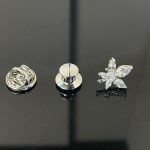The flower brooch stands as a captivating accessory that adds a touch of natural beauty and symbolism to any outfit. In this article, we delve into the enchanting world of flower brooches. Exploring their rich history, diverse designs. And the significant role they play in enhancing personal style. From their origins as decorative adornments to their enduring popularity in contemporary fashion.This comprehensive guide aims to shed light on the unique charm and significance of flower brooches as a symbol of natural elegance.

The Blooming History of Flower Brooches
1.1 Floral Adornments Throughout Time
In the begging, flower brooches have a long history, dating back centuries as decorative adornments. Since ancient times, flowers have held symbolic importance in various cultures worldwide. The practice of wearing floral adornments, including flower brooches, emerged as a way to celebrate nature’s beauty, convey emotions, and pay homage to significant events and traditions.
1.2 The Influence of Victorian Era Romanticism
During the Victorian era, flower brooches gained significant popularity, particularly due to the influence of romanticism and the fascination with nature. Inspired by the language of flowers and the sentimental symbolism attached to different blooms, flower brooches became a means of expressing love, friendship, and even secret messages. This era marked the height of floral-inspired jewelry, with intricate designs showcasing the delicate beauty of nature’s blossoms.

Diverse Designs and Floral Varieties
2.1 Artistic Interpretations of Flowers
Secondly, flower brooches come in a diverse range of designs, each capturing the essence of different floral varieties. From delicate roses and dainty daisies to vibrant sunflowers and exotic orchids.There is a flower brooch to suit every personal taste and style. These artistic interpretations showcase the intricate craftsmanship and attention to detail that goes into creating these wearable works of art.
2.2 Symbolism and Meaning
Beyond their visual appeal, flower brooches carry symbolic meaning that adds depth and personal significance to their wearer. Different flowers have long been associated with specific meanings and emotions. For example, a rose symbolizes love and passion, while a lily represents purity and innocence. By wearing a flower brooch, individuals can convey a message or embrace the symbolism associated with a particular bloom, allowing them to express their personality and sentiments.

Blossoming Style and Versatility
3.1 Versatile Styling Options
Flower brooches offer endless versatility when it comes to styling. They can be worn on clothing, such as lapels, collars, or even hats, adding a pop of color and natural elegance to any outfit. In addition, flower brooches can be used to accessorize accessories like handbags, scarves, or even hair accessories, allowing individuals to create unique and personalized looks. The versatility of flower brooches makes them a versatile and adaptable accessory for various occasions and ensembles.
3.2 From Casual to Formal
Flower brooches effortlessly transition from casual to formal settings, making them suitable for a wide range of events and occasions. Whether adorning a casual sundress or adding a touch of elegance to a formal gown, flower brooches bring a sense of natural beauty and refinement to any attire. Their ability to enhance various styles and outfits makes them a versatile accessory for fashion enthusiasts looking to elevate their personal style.

Embracing Nature’s Beauty and Sustainability
4.1 A Celebration of Natural Elegance
Flower brooches allow individuals to embrace and celebrate the beauty of nature. By wearing a flower brooch, individuals can carry a piece of nature’s splendor with them, even in urban environments. The delicate craftsmanship and lifelike details of these accessories capture the essence of blooming flowers, adding a touch of organic beauty to one’s personal style.
4.2 Sustainable and Ethical Fashion Choice
In today’s world, where sustainability and ethical fashion are gaining prominence, flower brooches offer a conscious choice to embrace eco-friendly accessories. Rather than opting for mass-produced accessories, individuals can choose vintage or handmade flower brooches, promoting a more sustainable approach to fashion. By supporting ethical practices and appreciating the beauty of handmade craftsmanship, individuals can make a positive impact on the environment and support local artisans.
Care and Preservation
5.1 Proper Storage and Maintenance
To preserve the beauty and longevity of flower brooches, proper storage and maintenance are essential. Storing them in a cool, dry place away from direct sunlight helps prevent damage and discoloration. Therefore, regular cleaning using gentle methods and avoiding harsh chemicals is crucial to maintain their delicate beauty. By taking proper care, flower brooches can continue to bloom and be cherished for years to come.
5.2 Expert Restoration and Repair
In cases where flower brooches require restoration or repair, seeking the expertise of reputable jewelers or restoration specialists is paramount. These professionals have the knowledge and skills to delicately restore flower brooches, ensuring their historical integrity and aesthetic beauty are preserved. Finally, with the right care and attention, even vintage or damaged flower brooches can regain their former elegance and continue to enchant for generations.

Embracing Nature’s Elegance with Flower Brooches
In conclusion, flower brooches serve as captivating accessories that bring a touch of natural elegance and symbolism to personal style. With their rich history, diverse designs, and versatile styling options. Flower brooches allow individuals to embrace the beauty of nature and express their personality. As a sustainable and ethical fashion choice, they offer a conscious alternative in a world focused on environmental responsibility. By preserving and wearing flower brooches, individuals celebrate the timeless beauty of nature and create a unique style statement that blooms with personal charm.


